
Caenorhabditis elegans is a free-living transparent nematode about 1 mm in length that lives in temperate soil environments. It is the type species of its genus. The name is a blend of the Greek caeno- (recent), rhabditis (rod-like) and Latin elegans (elegant). In 1900, Maupas initially named it Rhabditides elegans. Osche placed it in the subgenus Caenorhabditis in 1952, and in 1955, Dougherty raised Caenorhabditis to the status of genus.

Cymbidium, commonly known as boat orchids, is a genus of evergreen flowering plants in the orchid family Orchidaceae. Orchids in this genus are epiphytic, lithophytic, terrestrial or rarely leafless saprophytic herbs usually with pseudobulbs. There are usually between three and twelve leaves arranged in two ranks on each pseudobulb or shoot and lasting for several years. From one to a large number of flowers are arranged on an unbranched flowering stem arising from the base of the pseudobulb. The sepals and petals are all free from and similar to each other. The labellum is significantly different from the other petals and the sepals and has three lobes. There are about fifty-five species and sixteen further natural hybrids occurring in the wild from tropical and subtropical Asia to Australia. Cymbidiums are well known in horticulture and many cultivars have been developed.

Banksia elegans, commonly known as the elegant banksia, is a species of woody shrub that is endemic to a relatively small area of Western Australia. Reaching 4 m (13 ft) high, it is a suckering shrub that rarely reproduces by seed. The round to oval yellow flower spikes appear in spring and summer. Swiss botanist Carl Meissner described Banksia elegans in 1856. It is most closely related to the three species in the subgenus Isostylis.
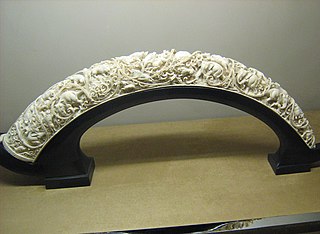
Ivory is an off-white color that resembles ivory, the material which is made from the teeth and tusks of animals. It has a very slight tint of yellow.

Cymbidium mosaic virus (CymMV) is a plant pathogenic virus of the family Alphaflexiviridae.

The elegant water shrew is a species of mammal in the subfamily Soricinae of the family Soricidae. It is monotypic within the genus Nectogale. It lives in Sikkim and China.
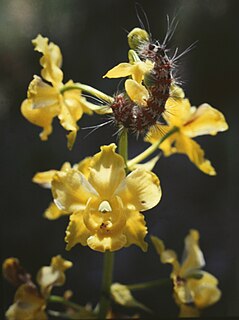
Cyrtopodium, often abbreviated Cyrt in horticulture, is a genus of more than 40 species of epiphytic and terrestrial orchids found from Florida and Mexico through Argentina. Cyrtopodium is the only genus in the monotypic subtribe Cyrtopodiinae.

Cymbidium aloifolium, the aloe-leafed cymbidium, is a species of orchid found in Asia, especially China and southeast Asia from Burma to Sumatra. It can be found growing between rocks or on another plant. The word cymbidium comes from the Greek kumbos meaning "hole, cavity" and the Latin specific name is just a translation of the English "aloe-leafed".

Cymbidium bicolor, the two-colored cymbidium, is a species of orchid found in South China to Tropical Asia.
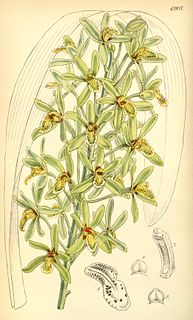
Cymbidium chloranthum, the green-flowered cymbidium, is a species of orchid.

Cymbidium dayanum, the Day's cymbidium, is a species of orchid, also known as the phoenix orchid or tree orchid.

Cymbidium eburneum, the ivory-colored cymbidium, is a species of orchid.
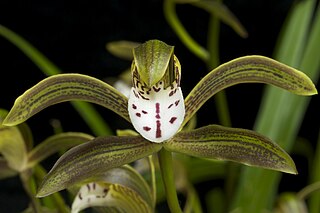
Cymbidium erythraeum, the Indian cymbidium, is a species of orchid.
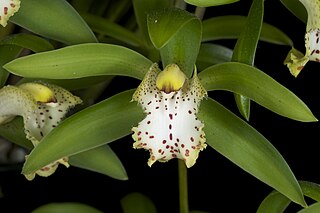
Cymbidium hookerianum is a species of orchid found in India, China, and Vietnam. It is distributed widely in Bhutan, especially in the cool temperate forests.

Cymbidium kanran, the cold-growing cymbidium, is a species of orchid.
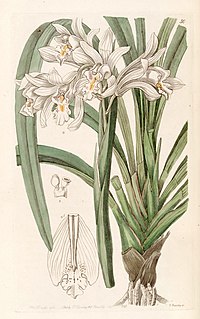
Cymbidium mastersii, the Master's cymbidium, is a species of orchid.
C. elegans most commonly refers to the model round worm Caenorhabditis elegans. It may also refer to any of the species below. They are listed, first in taxonomic order and, second, alphabetically.

Bauruemys is an extinct genus of turtles in the family Podocnemididae.

Cymbidium lowianum, called Low's boat orchid, is a species of orchid in the genus Cymbidium, native to Assam in India, Yunnan in China, Myanmar, Thailand, and Vietnam. It has gained the Royal Horticultural Society's Award of Garden Merit.


















